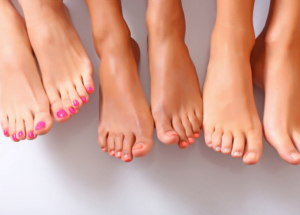Podiatrist, London Foot and Ankle Centre
Most women are quite knowledgeable about their body shape – whether they are an ‘apple’ or a ‘pear’ – and some of the health implications of their shape.
But are people equally informed about their foot shape? Many of the problems we see in clinic are directly related to the patient’s foot shape.
High arches and flat feet
Often, people are not aware of structural abnormalities, such as flat feet or high arches. Others are surprised to discover that their foot structure is the cause of their problems (and these problems can occur in a different part of the body, such as knees, hips, lower back, head and neck). One of the reasons for this is that people often manage perfectly well with an irregular foot shape during childhood and early adulthood. It may only be during middle-age, when muscles become less flexible and put pressure on joints and there may be weight gain, which mean foot shape starts to cause problems.
Additionally, foot shape can change. Both men and women over the age of 40 are likely to develop adult acquired flat foot, usually due to poorer function of the Tibialis posterior tendon in the midfoot and loss of strength and function in the ligaments running through the arch and rear of the foot. Weight gain and wearing heels are often exacerbating factors. Patients can be surprised to hear they have acquired flat feet, having had a regular foot shape at a younger age.
Simple solutions
Knowing your foot shape and the problems associated with irregular structures is very worthwhile, as it will enable problems to be identified earlier on and effective, usually simple solutions such as orthoses, appropriate footwear, stretching the calf muscle, strengthening the tendons and ideal body weight or prescribed weight loss.
Flat feet – common problems
- Increases the load on the arch and strain on the plantar fascia causing Plantar Fasciitis (heel pain).
- Increases the internal tibial rotation and malalignment causing knee pain.
- The calf muscle works harder to slow down the rotation of the leg therefore it can cause Achilles pain, Achilles Tendinopathy.
- The pressure on the inside of the foot is greater which could lead to bunions.
- Increases the internal leg rotation contributing to tight ITB, ITB Syndrome ( outside knee or hip pain).
- Can lead to an overuse of tendons in the legs contributing to Medial tibial stress syndrome, (shin pain).
- Stress fractures particularly metatarsal fractures may occur due to uneven distribution of weight and excessive movement of metatarsals.
- Damage to the ankle joint leading to arthritis because of the way the foot rolls in with each step, putting greater pressure on the ankle.
High arches – common problems
- Repeated ankle sprains, leading to ankle instability, are a particular injury risk.
- Feet are less mobile which may result in poor shock absorption.Therefore it is possible that this may predispose them to the development of stress fractures of the leg or foot (tibia, fibular, calcaneus and metatarsals especially fourth and fifth metatarsals).
- Increase lateral stress on the lower limb can contribute to ITB tightness and bursitis at the hip.


